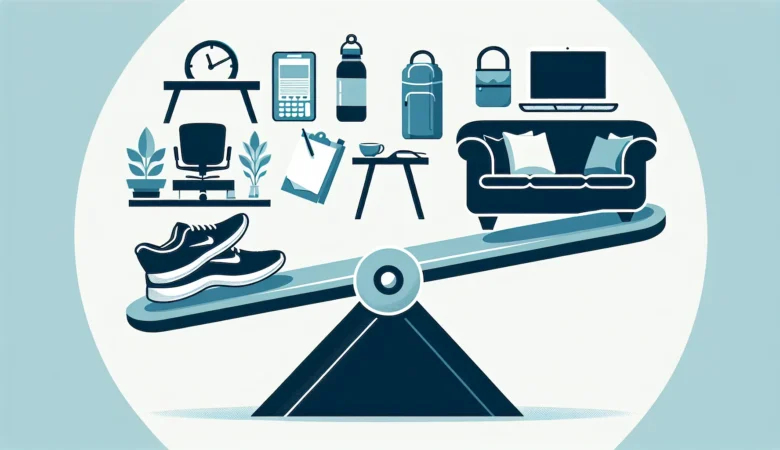Table of Contents
Article Summary:
- Introduction to the issue of excessive screen time and the need for digital detox.
- Understanding the impact of screen time on health and the importance of screen time management.
- Strategies to prevent health issues caused by excessive screen use, such as the 20-20-20 rule, a digital curfew, and physical activity.
- The significance of mindful social media use and establishing family screen time rules.
- Implementing a digital detox by setting screen time boundaries, allocating tech-free time, and occasional detox weekends.
- Achieving digital balance through mindful technology use, personal screen time guidelines, and engaging in productive screen time.
- Importance of engaging in offline activities as part of reducing screen time.
- Emphasizing the journey towards digital wellness as a gradual process and the need for self-compassion during the journey.
In today’s hyper-connected world, screen time has become an integral part of our lives. Yet, many of us yearn for a digital detox, an escape from the incessant pings, notifications, and the glare of our devices. The increasing awareness about screen addiction has led us to seek out effective ways to manage our screen time better. This article offers several strategies for you to regain control of your digital life, promoting digital wellness and mindful technology use. So, let’s dive into the realm of reducing screen time and rebalancing our lives.
Embrace Mindful Technology Use
“You can’t manage what you don’t measure.” – Peter Drucker
The first step towards managing your screen time is being aware of it. Start by tracking your screen time. Most devices offer built-in features that provide detailed breakdowns of your screen time. This insight will help you identify the apps you spend the most time on and discern the difference between productive screen time and mindless scrolling.
- Set Screen Time Boundaries: It’s important to create screen time boundaries. Establish screen time guidelines that work best for you. This might mean designating certain hours of the day as tech-free time, or setting screen time limits on specific apps.
- Mindful Smartphone Use: Begin to use your smartphone more mindfully. Try to avoid unnecessary notifications, and create a specific time slot to check emails or social media.
- Mindful Media Consumption: Be intentional about the content you consume. Opt for quality over quantity, choosing informative, enlightening content over mindless content.
Screen-Free Activities for Digital Well-Being
There is a whole world outside the digital realm that is rich, engaging, and fulfilling. Embracing screen-free activities can significantly contribute to digital well-being. Here are some engaging offline activities to help you unplug:
- Read a Book: Reading not only improves your knowledge but also enhances creativity and reduces stress.
- Outdoor Activities: Nature has a profound ability to refresh and rejuvenate our minds. Outdoor activities like gardening, cycling, or just a walk in the park can help you detach from the digital world.
- Practice Mindfulness or Meditation: Mindfulness exercises or meditation can help reduce stress and increase your focus away from screens.
Embracing Digital Minimalism
Digital minimalism advocates for a more intentional use of technology, limiting usage to activities that truly add value to your life. It’s not about completely unplugging from screens, but rather balancing screen time with other aspects of life.
By cultivating healthy technology habits, adopting screen time reduction strategies, and establishing family screen time rules, we can enhance our digital wellness and lead healthier, more balanced lives.

In the next part of this article, we’ll explore more about the impact of screen time on health, mindful social media use, and strategies for establishing healthy screen habits. Stay tuned for more insights and practical strategies to manage your screen time and embrace a life of digital balance.
The second part of our journey towards digital wellness involves understanding the impact of screen time on health and learning how to use social media more mindfully. By recognizing these impacts and adopting healthier habits, we can create a well-balanced digital life.
Screen Time and Its Impact on Health
It’s essential to understand that prolonged screen time can have significant health implications. Long hours in front of screens can lead to eye strain, sleep disturbances, and even mental health issues such as anxiety and depression. Therefore, managing our screen time habits effectively becomes crucial for our overall health.
Here are some helpful strategies:
- Follow the 20-20-20 Rule: To prevent digital eye strain, follow the 20-20-20 rule. Every 20 minutes, look at something 20 feet away for 20 seconds.
- Establish a Digital Curfew: Avoid screens at least an hour before bedtime to prevent sleep disturbances.
- Physical Activity: Incorporate physical activities into your routine to offset the sedentary nature of screen time.
Mindful Social Media Use
Social media platforms can be both a boon and a bane. On one hand, they keep us connected with friends, family, and current events. On the other hand, they can also lead to comparison, anxiety, and a feeling of being overwhelmed.
“The key to mindful use of social media is intentionality.”
Adopting mindful social media use involves being purposeful about why, when, and how you engage with social media. Setting time limits for social media use, unfollowing accounts that don’t add value to your life, and being conscious of your emotional reactions while using social media can contribute to a healthier digital life.
Screen Time Management for Families
Screen time management isn’t only an individual concern; it’s a family matter. Family screen time rules can help set a healthy tech-life balance for everyone. These rules might include tech-free dinners, no screens during family time, and setting age-appropriate screen time limits for children.
As we move to the last part of this series, we’ll delve into more strategies to reduce screen time, including the benefits of a technology detox and the importance of digital balance. We’ll also explore more ways to engage in offline activities that enrich our lives away from the screen.
Journey to Digital Detox: Embrace the Offline World
The final part of our guide to managing screen time revolves around two pivotal concepts: digital detox and finding the perfect balance between our digital and offline lives. Engaging in offline activities is not just beneficial for reducing screen time, but also for fostering deeper connections with the world around us.
Digital Detox: Unplugging from Screens
Digital detox — the deliberate reduction or elimination of screen time — is an effective strategy for those finding themselves overly reliant on screens. This doesn’t mean you have to entirely eliminate technology from your life, but rather, create healthier, more mindful relationships with it.

Here are some actionable digital detox steps:
- Establishing Screen Time Boundaries: Allocate specific hours for screen usage. Use screen time tracking apps to help you adhere to these limits.
- Setting Aside Tech-Free Time: Designate certain periods of the day as tech-free time. Use this time to engage in hobbies, exercise, or connect with loved ones.
- Detox Weekends: Consider a full technology detox over the weekend. It might seem daunting, but the results can be refreshingly liberating.
“Unplugging isn’t about running away from technology, it’s about taking control of it.”
Digital Balance: The Sweet Spot
Maintaining digital balance is about harmonizing our online and offline lives. It’s about deriving the benefits of technology without letting it rule our lives.
Digital balance might look different for everyone, but it usually involves mindful technology use, setting personal screen time guidelines, and engaging in productive screen time.
Engaging in Offline Activities
Part of managing screen time involves replacing it with meaningful, engaging offline activities. Try to cultivate hobbies and interests that don’t involve screens – be it gardening, reading a physical book, painting, or hiking.
Remember, reducing screen time doesn’t mean eliminating technology. It’s about creating a healthy balance between our digital and offline lives.
It’s time to embrace the journey toward digital wellness and to remember that every small step counts. Reducing screen time is not a one-day task but a gradual process. So be kind to yourself as you navigate this journey towards a balanced digital life.
“Technology is a useful servant but a dangerous master.” – Christian Lous Lange









